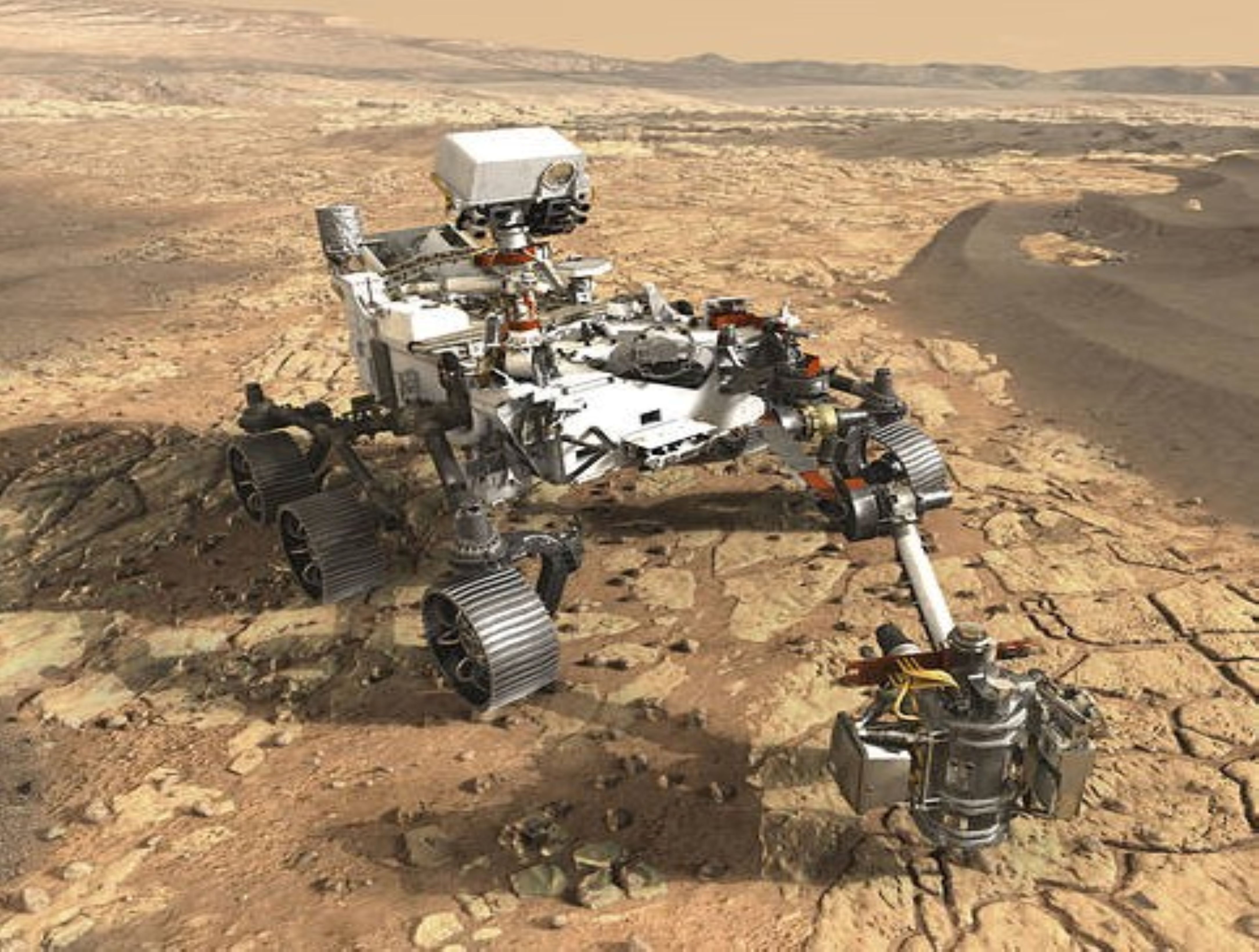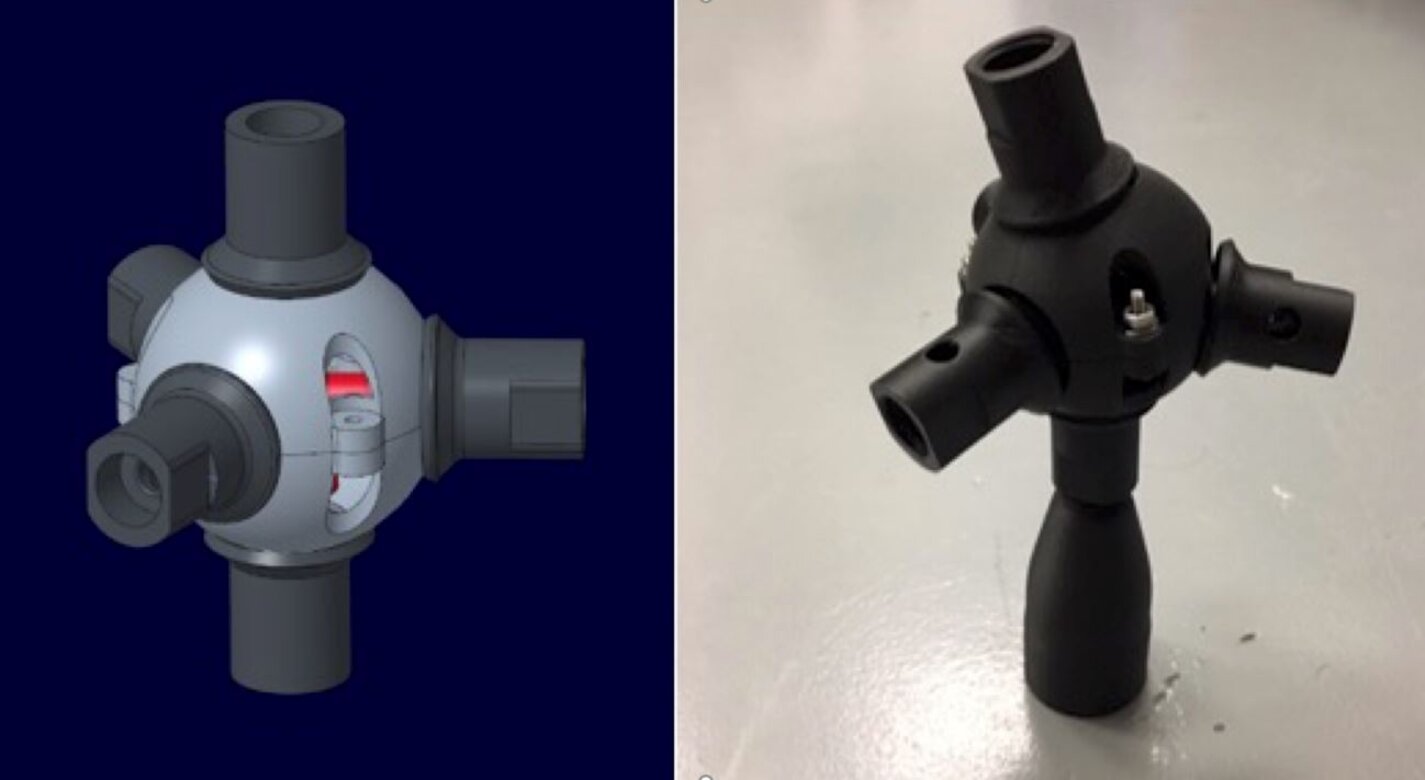Multi-Link Spherical Joint
Mechanical and Fluid Systems
Multi-Link Spherical Joint (MSC-TOPS-109)
Single joint allows six attachments with independent movement
Overview
Innovators at NASA Johnson Space Center have designed a spherical joint which allows up to six linearly actuated links or attachments to rotate about a co-located center. Originally designed to provide joint flexibility necessary for a variable geometry truss system, the new spherical joint also allows power and data lines to pass through it without the lines being subjected to structural forces. This technology can be key for creating a deployable, variable geometry truss system, with a compact form factor that can reduce payload volume within the confines of a launch or other transport vehicle. Typically, flexible truss systems rely on joints where each of the links do not rotate around the same point, creating instability in the joints and the entire structure. The Multi-Link Spherical Joint removes those instabilities, allowing for a durable and adaptable technology with multiple space and terrestrial applications.
The Technology
The Multi-Link Spherical Joint developed at NASA Johnson Space Center provides a substantial improvement over typical joints in which only two linearly actuated links move independently from one another. It was determined that the rotation point of a trussed link needed to be collocated at a shared point in space for maximum articulation. If not allowed separate rotation, the line of action through a universal joint and hinge acts effectively as another linkage. This leads to a much more complex and uncontrollable structure, especially when considering multiple dimensions.
Comprising the Multi-Link Spherical Joint, a spherical shell encases the cupped ends of each six possible attachments and allows each of those attachments to be independently controlled and rotated without inhibiting the motion of the others. To do this, each link is precisely limited to 15 degrees of rotation off the link centerline, thus allowing a total of 30 degrees of rotation for each link. The shell-and-cup structure can handle the loads of linear actuators that may be used to control and vary the geometry of a truss system utilizing the new joint technology. The calculated operating load that the truss system must handle can be used to scale the size of the joint, further allowing customization of any potential truss system. Additionally, the incorporated linear actuators can be controlled and powered by wiring routed through the joint without putting undo stress on the wires during operation. Accordingly, this innovative joint technology enables more efficient deployment and precise operation of articulating structures.
The Multi-Link Spherical Joint is at technology readiness level (TRL) 4 (component and/or breadboard validation in laboratory environment) and is available for patent licensing. Please note that NASA does not manufacture products itself for commercial sale.


Benefits
- Flexible: each attachment rotates independently
- Controllable: each link can be independently controlled
- Customizable: six possible links instead of the typical two
- Deployable: promotes smaller form factor deployable systems
- Manufacturable: shell-and-cup design can be easily made and assembled
Applications
- Aerospace: robotic manipulator arms; space telescope structures; surface habitats
- Robotics: articulating appendages, parallel robotics such as flight simulator platforms
|
Tags:
|
Similar Results

Composite Joint Connector
This technology is a joint connector for application between two or more tubular parts, or to connect one or more tubular parts to a fixed structure. This attachment technology is more structurally efficient and reduces failure characteristics due to the uniformity of composite material across the joint. In comparison to a typical joint, this technology reduces weight while minimizing stress variations that lead to structural failure. Moreover, typical joints must be bonded or screwed together, which further reduces efficiency. The invented technology, however, is designed so that it is both bonded and mechanically locked by design rather than relying on separate mechanical fasteners. The result is a design that mitigates failure of a structural joint.

Cord Tension Measurement Device (C-Gauge)
The C-Gauge is made of a 3D-printed aluminum body with strain gauges attached to the inner and outer walls of the connecting beam. The legs of the gauge attach firmly to the cord. When the cord is stretched, the tension in the cord goes through the legs and into the beam, causing it to bend. This bending creates a tension and compression stress in the bottom and top surface of the beam, respectively. The strain gauges capture the tension and compression, which are then used to determine the tension in the cord. The use of multiple strain gauges mitigates any torsion loading of the gauge and provides a direct measurement of the axial tension load of the cord.
The C-Gauge is a low-profile, non-invasive system that can be installed onto an existing cord in a system (e.g., the suspension, reefing, or riser lines in a parachute) without the need to remove or re-install the cord. It is small and lightweight and does not add stiffness or weight to the cord and thus does not affect the dynamics of the parachute or the structural response of the system. The C-Gauge can be scaled to larger and smaller sizes to measure larger and smaller load capabilities, dependent on the cord.
The C-Gauge is at a TRL 4 (component and/or breadboard validation in a laboratory environment) and it is now available for your company to license and develop into a commercial product. Please note that NASA does not manufacture products itself for commercial sale.

Soft Mate Lifting Device
The Soft Mate lifting device is a below-the-hook tool that provides initial and gentle contact between mating connections while using a crane. The device utilizes a set of rolling lobe airbags to add a pneumatically adjustable soft spring into the lift rigging of a crane. The device is particularly useful for NASA's testing of the SLS, which requires the assembly and disassembly of hundreds of threaded load lines. While the load lines have relatively large diameter threaded connections to join components, the fine threads can be easily damaged by impact or misalignment. The added softness of the Soft Mate's airbag system helps maintain a neutral load on the threads to prevent galling as they are manually screwed or unscrewed.
The current state of the art in precision placement of objects by cranes is a below-the-hook hydraulic system that does not add any elasticity in the lift rigging and requires the user to constantly adjust the hydraulic pressure to maintain a neutral force on objects being joined. By virtue of the pneumatic core, the Soft Mate lifting device provides the needed elasticity while minimizing user interaction during lifting and placement. Although designed particularly to aid in NASA's SLS threaded load line assembly, the extra compliance provided by the Soft Mate system may also benefit other applications where additional control and precision are required for placing or mating heavy components. The Soft Mate design has undergone extensive stress analysis and is based on commercially available components that can be scaled and optimized for different weight requirements. The system provides the flexibility needed to assemble heavy components with threaded connections or other precision crane placement applications where greater compliance is needed.
.jpg)
Shape Memory Alloy Mechanisms for CubeSats
Most spacecraft feature release, retention, and deployment devices as key components, because these devices achieve on-demand configurability of solar panels, probes, antennas, scientific instruments, fairings, etc. Until now, designing and using such devices in small spacecraft has been a challenge, because their mass, volume, and power requirements are significant and can impose design constraints. CubeSats, in particular, often need to deploy several structures (such as solar arrays) simultaneously, which prior-art deployment devices have not been able to manage effectively. Glenn's innovation embeds SMAs within the components so the structures can be retained during launch, then released and deployed in orbit. The release and retention device is controlled by an SMA activated pin puller to disengage the release plate from the hooks holding the solar arrays. Once released, the SMA hinge is passively enabled to the deployed state. When ready on orbit, the mechanism is commanded to release and electrical power is sent to the SMA actuator, releasing the component to its deployed state. The component is deployed to its final position through the use of hinges, which are activated passively with SMA spring strips. The retention and release device and hinge are substantially smaller and lighter than deployment mechanisms have ever been and can deploy simultaneously with great reliability. Having already been successfully deployed on a NASA mission, Glenn's innovation is a game-changing technology for CubeSats and other small satellites.

Robotic system for assembly and maintenance of lightweight reconfigurable structures
To enable the goal of autonomous assembly of high performing structures, a robot system must be able to travel across a lattice structure in all dimensions, transport and align a unit cell module to the correct location and fasten the module to the existing structure. In this system, a team of multiple mobile bipedal robots work together to carry, transfer, and place 3D-lattice modules (e.g., cuboctahedron voxels) to form a 3D lattice structure. The team of mobile bipedal robots autonomously provide transportation, placement, unpacking, and assembly of voxel modules into functional structures and systems. As the team of mobile bipedal robots live and locomote on the 3D-lattice structure, they monitor health and performance, enabling repair and reconfiguration when needed. The mobile bipedal robots work together in different roles, for example, one as a cargo transport robot and the other as a crane robot. The cargo transport robot and the crane robot work together to move the voxels from one location to another. Each robot includes at least one electronic control module that receives commands from another robot or a central control system. A central control system implements a plan to control the motion sequences of the robots to maximize efficiency and to optimize the work required to completely assemble a structure. The plan is pre-computed or computed during implementation by the central control system or the robots themselves, according to algorithms that utilize the regularity of the lattice structure to simplify path planning, align robotic motions with minimal feedback, and minimize the number of the degrees of freedom required for the robots to locomote across and throughout the 3D-lattice structure and perform structural assembly.



